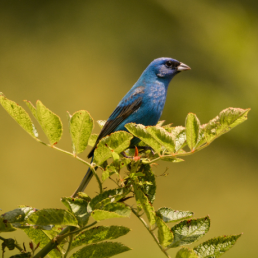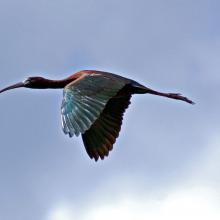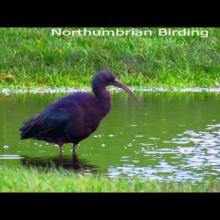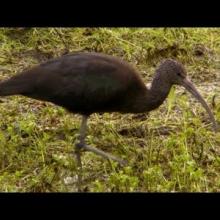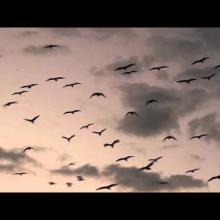

Join BirdNote tomorrow, November 30th!
Illustrator David Sibley and actor H. Jon Benjamin will face off in the bird illustration battle of the century during BirdNote's Year-end Celebration and Auction!
Some birds stay put all year. Some migrate with the seasons. And some, like this Glossy Ibis, are dispersing across new regions. Glossy Ibises breed on all the continents except Antarctica. But they were almost unknown in the US, even in the 19th century. Glossy Ibises crept slowly into the Southeast by the early 20th century, and after about 1950, they expanded rapidly. By the 1980s, they had spread well into the Northeast and even Canada. Their US range now overlaps with another ibis — the White-faced Ibis — which is also expanding its range.
BirdNote®
Glossy Ibises - On the Move
Written by Bob Sundstrom
This is BirdNote.
[Glossy Ibis calls, http://macaulaylibrary.org/audio/22414]
Some birds stay put all year. Some migrate with the seasons. And some are truly on the move, dispersing across new regions, increasing their range in sometimes dramatic fashion.
[Glossy Ibis calls, http://macaulaylibrary.org/audio/22455, 1.06-1.10]
The Glossy Ibis is such a bird. Standing about two feet tall, the Glossy Ibis is a marsh bird with a long, slender, down-curved bill. In a certain light, it can appear black. But when the sun hits one just right, the bird shimmers iridescent maroon with sparkles of emerald.
[Glossy Ibis calls, http://macaulaylibrary.org/audio/22414, 0.08-.10]
Glossy Ibises breed on all the continents except Antarctica. But they were almost unknown in the US, even in the 19th Century. John James Audubon saw just one in his lifetime. They crept slowly into the Southeast by the early 20th century, but after about 1950, they expanded rapidly. So by the 1980s, they had spread well into the Northeast and even Canada.
[Glossy Ibis calls, http://macaulaylibrary.org/audio/22414, 0.08-.10]
This was but a small piece of a greater expansion, though. Glossy Ibises are relative newcomers to the New World, first reaching South America around 1800.
Their US range is now edging ever westward, to overlap with another ibis – the near look-alike White-faced Ibis – which is also growing its range.
You can find photos of both, when you come to our website, BirdNote.org.
[Glossy Ibis calls, http://macaulaylibrary.org/audio/22414, 0.08-.10]
I’m Mary McCann.
###
Bird sounds provided by The Macaulay Library of Natural Sounds at the Cornell Lab of Ornithology, Ithaca, New York. 22414 and 22455 recorded by William E. Davis Jr.
BirdNote’s theme music was composed and played by Nancy Rumbel and John Kessler.
Producer: John Kessler
Executive Producer: Sallie Bodie
© 2016 Tune In to Nature.org December 2016 Narrator: Mary McCann
ID# GLIB-01-2016-12-05 GLIB-01
